Growing outdoor tomatoes in the subarctic and Alaska is not impossible. It’s actually quite possible to do, even without a greenhouse.

It does take some care to grow them outside, but you can have ripe tomatoes in time for that early first frost!
The techniques we discuss in this article are applicable to almost any cold climate out there. You may need to slightly adjust times and dates based on your actual last frost dates. If your growing season is in the three month range, these tips will apply!
Tomatoes are a tropical plant, they would never grow naturally up north if it weren’t for gardeners planting them. Most tomatoes love warm summer days and better yet, still-warm evenings.
The interior of Alaska, and many northern areas, are surprisingly warm enough over the summer for growing tomatoes, especially when you care for a few specific things.
Start With Good, Cold Climate Tomato Genetics
Growing tomatoes in the subarctic and other cold climates starts with good genetics.
Fortunately, these days, many tomato varieties exist. Some varieties are even bred specifically for growing in cold climate areas.
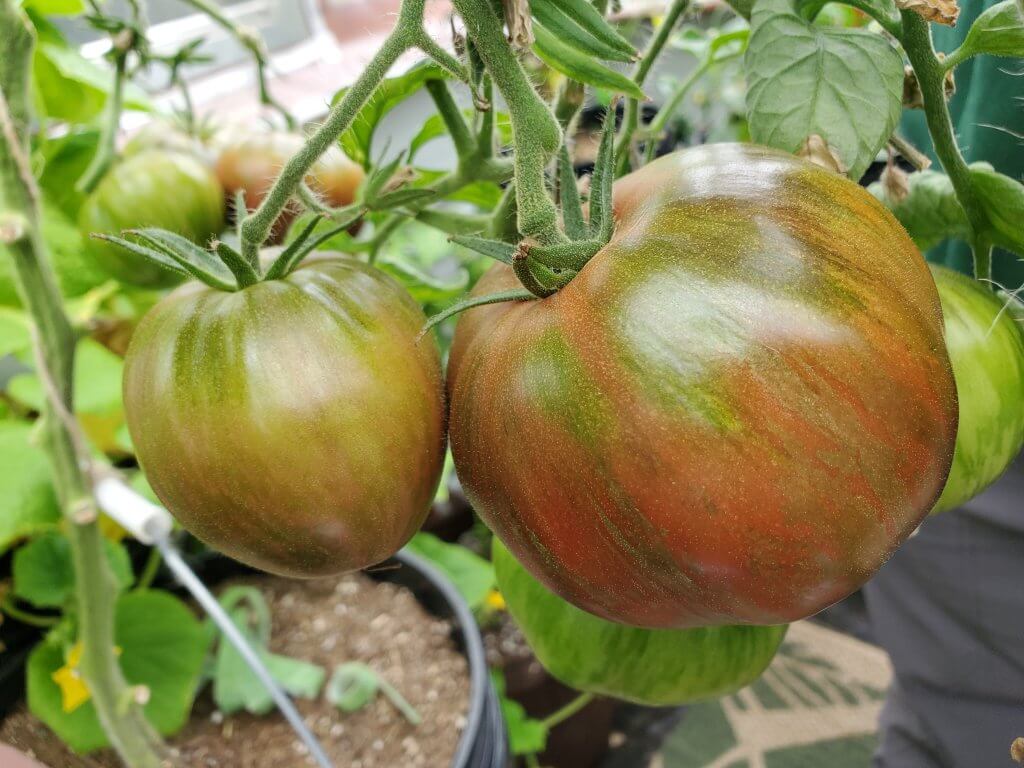
Look For Traits, Not Varieties!
We’d like you to focus more on the traits that you’re looking for, as opposed to specific varieties. This will open up your options more than following exact variety lists.
Sure, take some hints from the “pros” and grow what they tell you works well, but don’t be afraid to try something different. There are many vendors out there who sell tomato seeds specifically marketed towards cooler climates.
You should typically seek varieties that will mature in 75 days or less, to offer enough time for ripening. You may also see them called “early” varieties, which means that they will mature earlier than most.
We’ve seen a number of Russian/Siberian, Canadian and eastern European varieties that are suitable for cooler climates. They can be indeterminate or determinate varieties, both types will work with our imminent and unforgiving early first frost.
Most tomatoes that will do well in the extreme north tend to be smaller varieties as well. Not just cherry tomatoes, but other varieties that grow to 2-3 inches.
That’s not to say you can’t grow a two pound whopper up here. You absolutely can. It just might be green when you pick it:
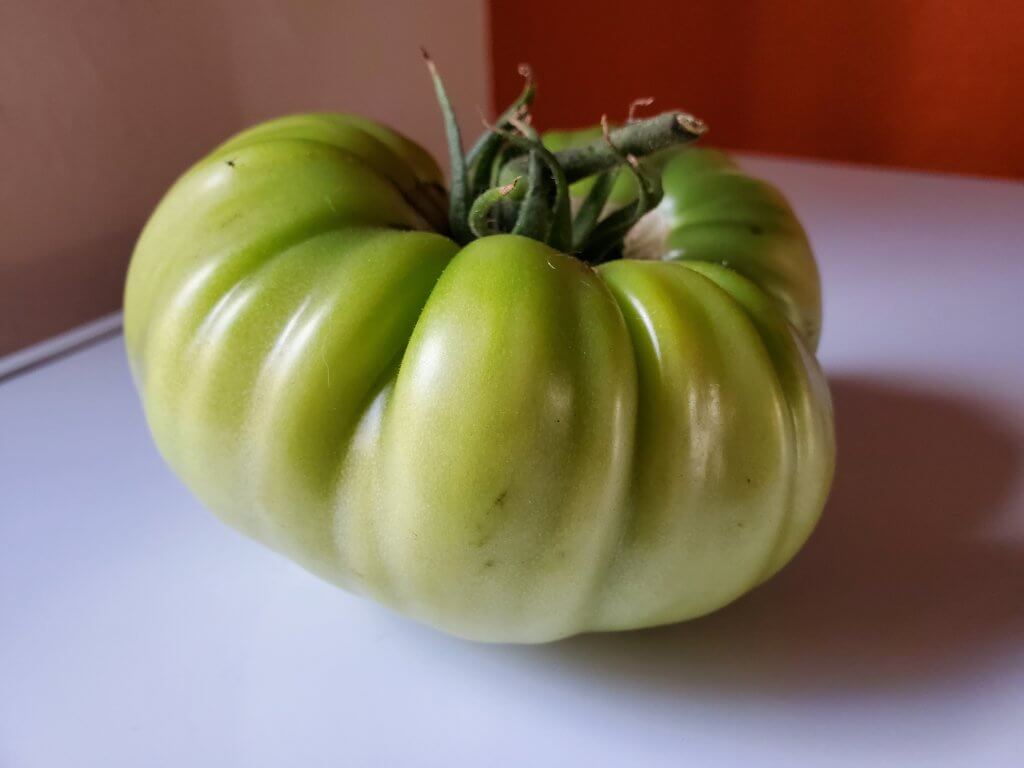
You can grow some really big tomatoes under the midnight sun! However, larger tomatoes tend to require more time to ripen properly. Smaller varieties tend to have better success up north.
Examples Of Cold Climate Tomato Genetics
There are many varieties that are specially bred for cold climates and the Alaskan outdoors. Some examples of these varieties are:
- Stupice (pronounced stoo-peach-ka)
- Polar Beauty
- Alaska
- Sub Arctic
- Glacier
- Early Tanana
- Polar Star
- Beaverlodge
- Manitoba
- Northern Lights
- Silvery Fir
- Azoychka
- Thessanoliki
- Moscow
- Purple Russian
- Most cherry tomato varieties, especially early varieties, have produced well for us
- Check out the UAF Extension service variety list for other varieties that have been tested in Interior Alaska.
Your local nurseries will likely sell tomato starts that are going to do well in your area. They have every incentive to get you to come back next year!
It might be wise to avoid “big box stores” and such, at least that’s been our experience in Alaska. They often get varieties that might do well “in the north” but not necessarily the extreme north.
If you have a greenhouse, your options are a lot more diverse. With these, you could look at 80+ day tomatoes, including some prize-winning heirloom varieties. Early varieties are still going to be a good bet, though. You will have superior results if you can heat your greenhouse into the early fall as that’s prime ripening time.
Diversify Your Tomato Crop
A great piece of advice we’ve learned over the years is to diversify your crop. Don’t grow just one kind of tomato, grow several different kinds if you can.
Different weather patterns can adversely affect one variety versus others. We’ve had years where one variety didn’t produce well and others have. Sometimes, different gardeners get very different results from the same plant! One thing is certain, you should try to learn what works well for you.
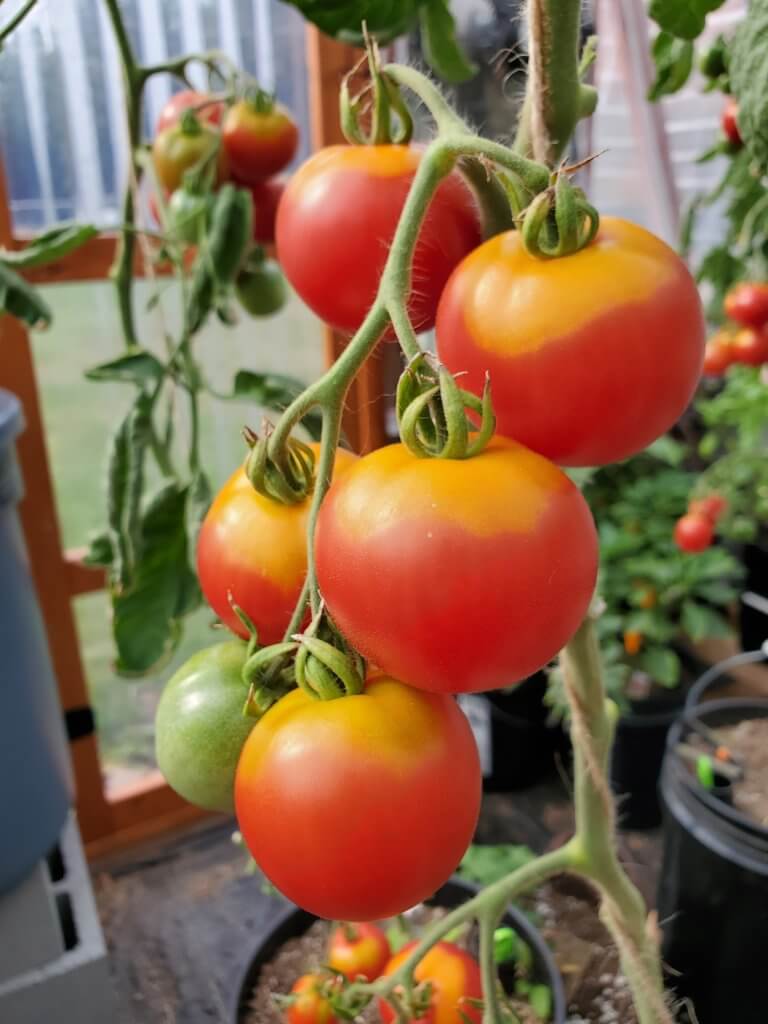
Growing several different varieties not only will guarantee more choice, it will fundamentally protect you against single crop failure. There are no issues with growing multiple types of tomatoes side by side, such as with cross-pollination.
We usually test a new variety every year as we want to learn for ourselves what does and doesn’t work. But, if a variety doesn’t do well over a couple of seasons, we don’t bother growing it. We’ve learned to let go of nostalgia in our subarctic gardening. Some varieties just can’t handle our cooler evening temperatures and won’t produce well in our cooler environment.
Get An Early Start On Your Tomato Crop
It isn’t practical to grow tomatoes from seed entirely outdoors in cold climates. The season just isn’t long enough to allow the plant to fully mature and produce a good crop.
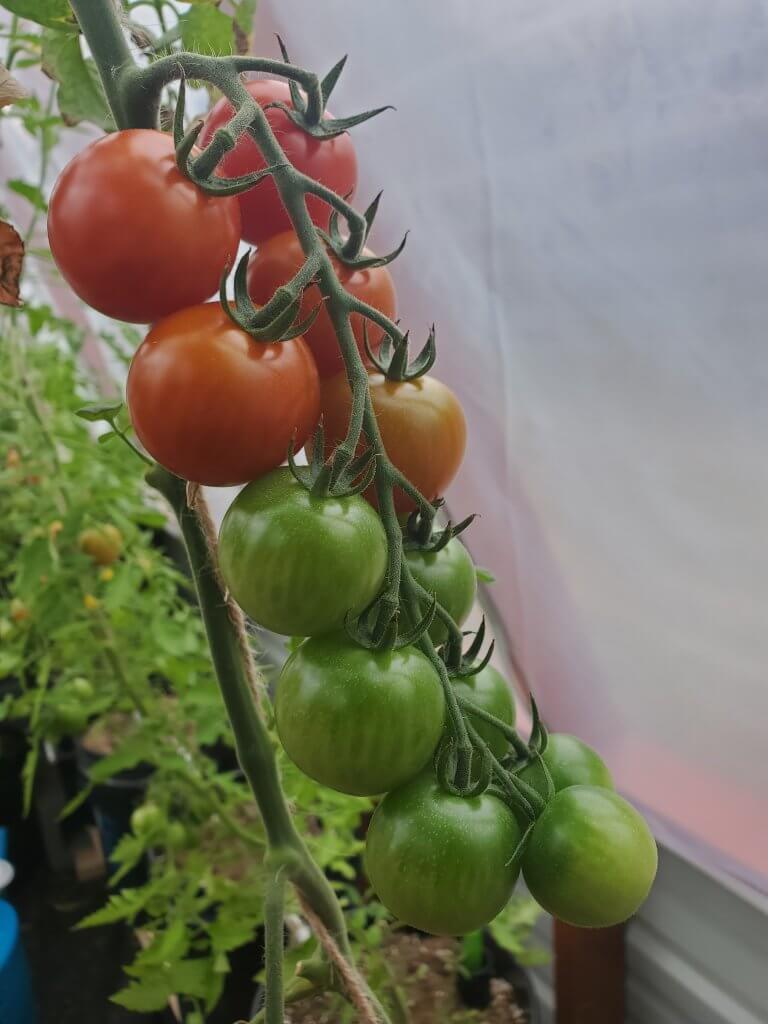
A successful bounty of tomatoes will require you to start your seedlings indoors or purchase tomato starts from a nursery.
Tomato seeds will germinate best in warmer soils. Try to aim for above 65 degrees Fahrenheit and preferably over 70 degrees. Tomato seeds will be finicky, at best, in cool soils!
Tomato Planting Schedule
If you intend to grow your tomatoes outdoors, plan on planting those seeds 5-8 weeks before last frost. In the interior of Alaska, last frost is recognized as June 1st.
If you have space and lighting for larger indoor tomato starts, the earlier of those dates will result in more mature and better fruiting plants. If you are cramped for indoor growing space, the later of the dates will still work in our northern environment.
For those that intend to grow tomatoes in a greenhouse, you can start tomato seeds as early as 8-10 weeks before last frost. This will allow you to transfer your tomatoes into your greenhouse 2-3 weeks prior to last frost, which for interior Alaska is about mid-May.
Some people start their tomatoes very early. The earliest we’d recommend sowing tomatoes would be 10 weeks before last frost. This really requires a climate controlled greenhouse as your plants are going to be 3+ feet tall when it’s safe to actually plant them!
Pick The Warmest Spot For Growing Tomatoes
You want a site that will be as warm as possible during the day. Tomatoes aren’t terribly fussy about the amount of daylight they receive, but aim for about 8 or more hours per day.
I honestly wouldn’t worry about the summer sun just below the arctic circle. Sun equals warmth and we want as much as we can get.
You definitely want to avoid areas that are heavily shaded throughout the day. If you are assessing areas for a tomato garden, your best places will be where the snow melts first during spring. Chances are good that if snow tends to stick around in an area, the ground will be a bit too cool for tomatoes. This will hamper your tomato growth.
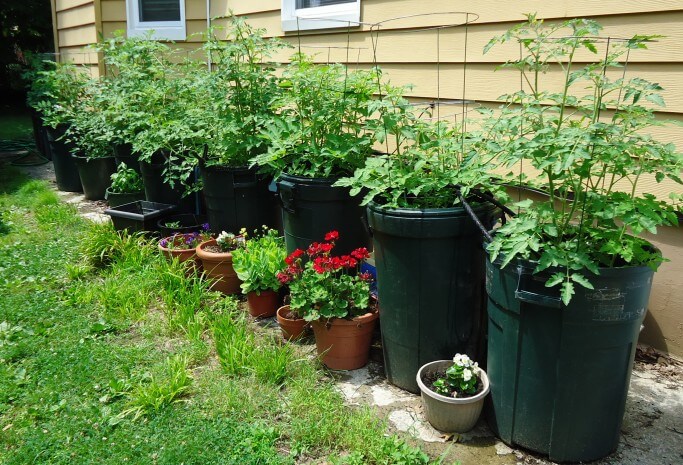
This location for tomatoes has a lot of things going for it. It has stone insulating the plants from the ground. It is also near the home, which will radiate heat. Dark colored containers are also a great way to provide extra soil warmth for tomatoes, which can be a major advantage in cooler climates.
It’s a good idea to utilize things that can help provide residual warmth. If you can keep your tomatoes near your home, you can get reflective heat! Placing your tomato containers on concrete will allow your plant to pull heat from it.
Every little bit helps when growing outdoor tomatoes. If you think a technique or particular placement might help your tomatoes, it’s worth at least trying.
Keep Your Tomato Roots Warm
Remember that soil warms much less quickly than the air does. While the ambient temperature may be well within a tomato’s preference, the soil underneath could take a lot longer to warm up to similar temperatures.
You will do well by picking an area with the warmest soil possible. This may be a raised bed or even raising them as a container plant in a regular, fabric or sub irrigated pot.
Our side-by-side testing has shown that outdoor tomatoes do better in containers than any traditional ground based garden here in the subarctic.
If you are using containers, getting them off the ground will also help a lot. Placing them on a deck will be warmer than the ground. If you have concrete or stone you can place them on, this will help provide residual heat as well.
Black containers will absorb more heat, which is a good thing in cold climates.
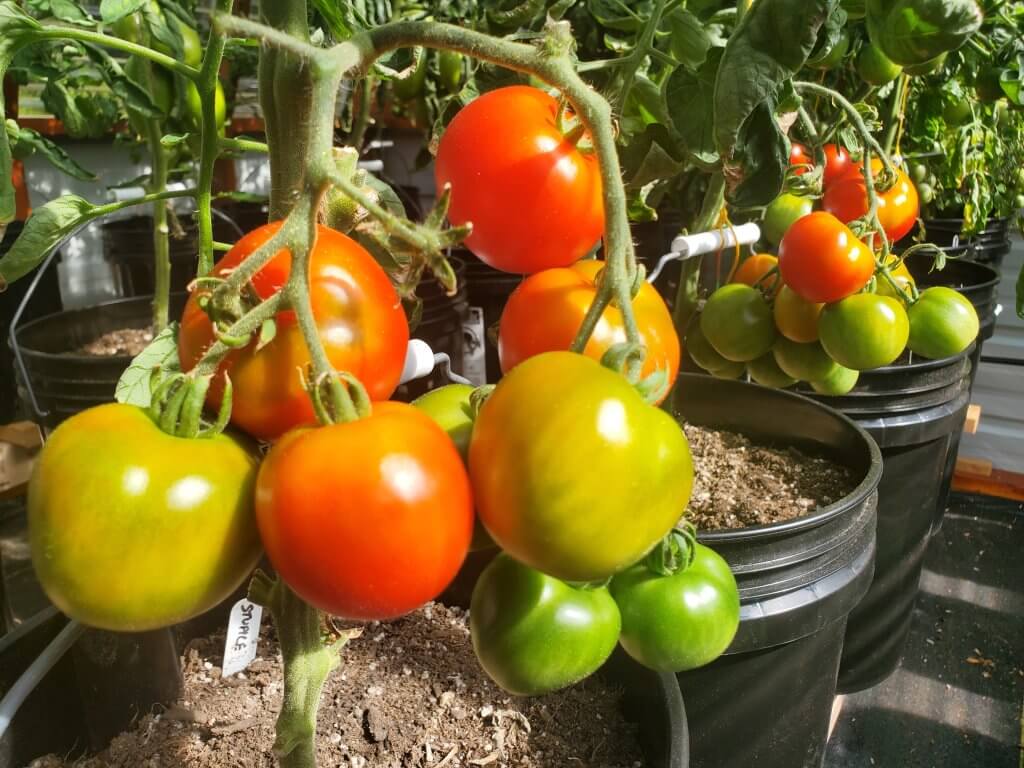
If you must grow in the ground, using mulch over the soil is a good practice. You can use black IRT (infrared transmitting) plastic, weed fabric or some other dark mulch.
Mulch will help to trap the heat in the root zone, which is especially important for our cooler evenings. The soil will warm up more quickly and release its heat more slowly than exposed soil will.
Using raised rows will also increase in-ground temperatures, if you are trying to grow in the ground.
If you are growing in an area where permafrost is known to exist, your best bet is to definitely get your plants off the ground. In this situation, plan on either using an elevated raised bed (off the ground) or growing your tomatoes in containers. There is no other way.
Adjust Your Tomatoes To Outdoor Temperatures Gradually
Tomatoes are a tropical plant. They aren’t used to our cold summer nights. The shock of going from indoor temperatures to a 38 degree night is enough to kill a young tomato plant.
If you can, while you are hardening off your plants, gradually introduce them to our outdoor evening temperatures. As you are hardening off your plants, start with warmer days preferably over 50 degrees Fahrenheit.
When possible, gradually introduce your plants to cooler periods, such as in the evening. If there are particularly warm evenings predicted (over 50 degrees Fahrenheit), you can leave them outside overnight if they’ve been sufficiently hardened off. Eventually, they will take to the cooler weather and transplant to their final home will be easy on them.
We have had no problems with our tomatoes surviving even sub 40 degrees, but they were gradually introduced to those temperatures.
If there is any danger of frost, and you can’t bring your plants inside, you may want to use frost cloth (sometimes called remay cloth) to protect your plants.
Feed Your Tomatoes Appropriately
Feeding your plants regularly is important. Our vast periods of sunlight in the subarctic keeps our plants in constant overdrive.
Often times even a rich compost won’t be enough and you will need to supplement with additional plant food.
Tomatoes are a fairly hungry plant and will benefit from fertilization. After germination, they will take well to nutrient rich soils with plenty of composted materials.
Once your plants have a 2-3 sets of true leaves, feed your tomato seedlings with a nitrogen rich fertilizer. This will help them get big and strong so they can produce many tomatoes. You can use most all-purpose fertilizers early in the plant’s life (pre-bloom), where nitrogen is the most important component.
Use A High Quality Tomato Focused Fertilizer
Once you have transplanted outdoors or to your greenhouse, you’ll want to switch your fertilizer to a tomato focused fertilizer.
We really like Epsoma’s Organic Tomato-tone or JR Peter’s Tomato Feed for this purpose. Despite the name, these will also work well on other veggies too.
Tomato specific fertilizers are a little different from normal “all purpose” fertilizers in that they contain calcium and magnesium, both of which tomatoes need. This will make sure the tomatoes have a complete nutrition and will encourage them to produce blossoms and subsequently, bountiful fruit!
Fertilize based on the recommended schedules for your fertilizer. For most fertilizers, this will be something like every 7-10 days, or maybe every 14 days.
It’s also wise to keep an eye on the weather. If you see a week or more of nice warm weather, fertilizing early in that cycle will allow it to take advantage of the heat and grow well. Likewise, if rain or cooler temperatures are predicted, it might be better to hold off on fertilization until nice weather returns.
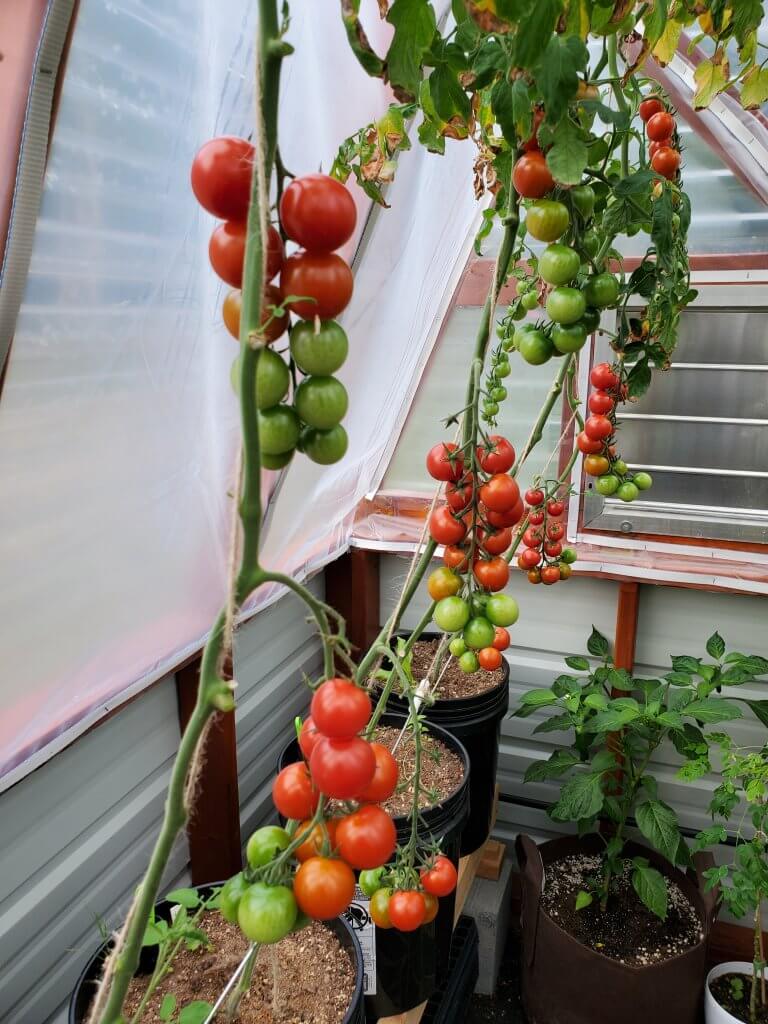
A little note about watering. Tomatoes are sensitive to drought conditions, so you want to make sure your plants are continually watered. Tomatoes that experience droughts can experience cracking and other problems.
Maintaining water can be challenging in containers as the available water can get used up quickly!
Sub irrigated containers or irrigation systems can ease irrigation concern significantly. Also, remember that big rainfalls can leech fertilizer out of your soil, so maintain your fertilizer schedule.
Manually Assist Your Tomatoes With Pollination
Even if you happen to have a bee hive next door to your tomatoes, your harvest will benefit if you assist with pollination.
Tomatoes are self pollinating, so they do not require pollen to travel from flower to flower.

All you have to do is gently tickle/shake/wiggle the tomato’s flower clusters. This will cause the pollen to “break loose” and sufficiently fertilize the flower, resulting in a tomato growing site.
We usually do this once every day or two as the flowers come into bloom. This effort will more or less guarantee a tomato will grow there. Manually assisting pollination will greatly enhance your production and your yields will be larger.
If you’re manually pollinating your flowers and still not getting tomato growing sites, the problem is usually something else. Most often, this is a temperature related problem and the particular genetics are not great for subarctic growing.
Some people use electronic toothbrushes and other gizmos for assisting with pollination. Do whatever you think is right, but we’ve had great success by careful use of our fingers.
Use Poly Covers or Cheap Greenhouses To Trap Heat For Your Tomatoes
The focus of this post is outdoor tomatoes in the subarctic. But, there’s no getting around that tomatoes like warmer conditions.
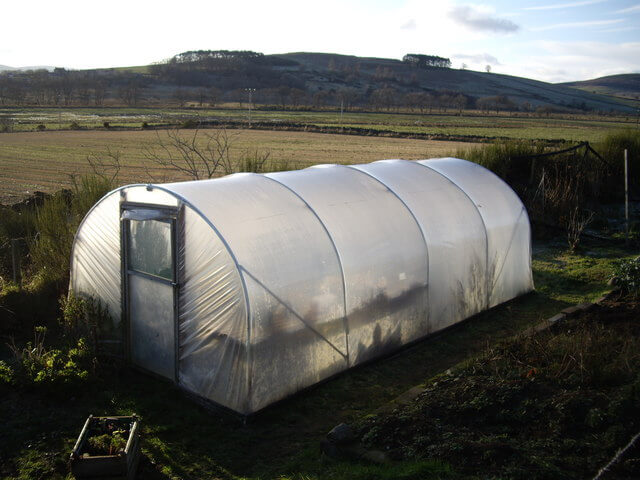
A greenhouse or hoop house will significantly increase your ability to produce tomatoes in the subarctic. It is orders of magnitude better than outdoor growing.
Even an unheated greenhouse will provide exponentially better harvests in the subarctic.
With greenhouses, the absolute best thing you can do is to build a permanent or semi-permanent greenhouse with appropriate temperature control and ventilation. There are many plans and ideas out there which can fit into a lot of different budgets. This isn’t in the cards for everyone, though.
Alternatively, there are relatively inexpensive plastic greenhouses that can be found at places like Amazon and local hardware stores. They are temporary and must be taken down for the winter. Most of these won’t last more than a few seasons, but they are cheap enough and offer you flexibility you won’t have otherwise.
You can also make a poly tunnel out of PVC and some clear poly tarp. The tarp material can often be found at local nurseries and can also be purchased on Amazon. There are lots of tutorials on-line about how to build a poly tunnel. Just make sure you secure the structure in the event wind picks up.
PVC is not the best material for handling snow load. If you live where there is a lot of snow, you may find it beneficial to remove the plastic covering for winter or to base the hoop house on metal tubing.
Greenhouses and high tunnels are a double-edged sword. During the day, if there isn’t proper ventilation, you can easily produce plant killing temperatures. Seriously, 130 degrees on a 60 degree day is not impossible and that will kill your tomato plants quickly.
Proper venting is critical. You might want to read our article on small greenhouses and temperature control as a primer for greenhouse ventilation.
Prune Your Tomato Plants Properly
There are two major kinds of tomatoes, determinate and indeterminate.
The basic difference between these is fairly simple. Determinate tomatoes will grow to a certain height and size and most of the fruit will produce at one time. Indeterminate tomatoes will continue growing as long as conditions allow, with fruit appearing at different stages.
You need to know what you are growing because they are pruned differently from one another. A seed packet or research on the internet of your varieties is essential.
Indeterminate Tomato Pruning
With indeterminate tomatoes, you will need to learn about suckers. A sucker is a new stem that will form at the internodes, typically at a 45 degree angle to a leafed branch.
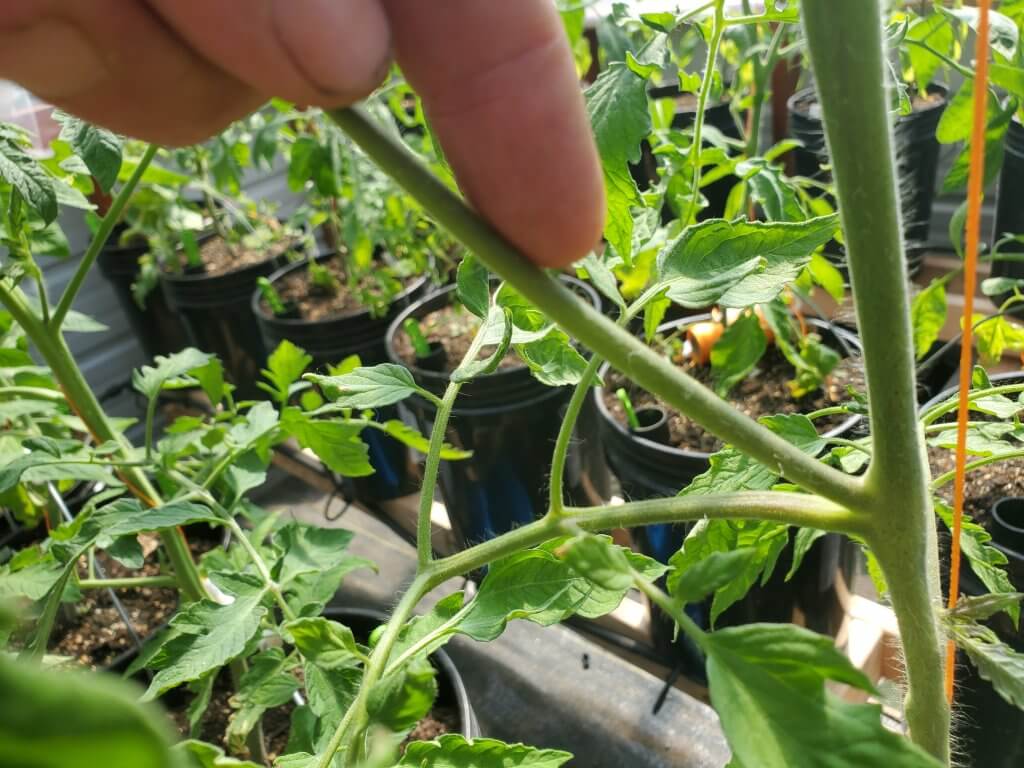
This image shows a tomato sucker. It usually comes in between the main stem and the perpendicular leaf branch. If left on the plant, it will become a new main stem.
If suckers are left on the plant, it will turn into another main stem and your plant will soon be growing every which way.
Throughout the season, you should be trimming suckers off as much as possible to allow your plant to put energy into producing fruit and vertical growth. We want the plant to focus on growing tall, not wide.
Once the plant is somewhat sizeable (about 3 feet/1 meter tall), you want to remove the bottom foot (30cm) of branches. This will promote better air circulation among the plants and help wards of disease and pests. We trim all branches up to the first flower cluster.
Also, if you are growing indeterminate varieties, about a month before the first frost, aggressively prune your foliage. Be sure to leave the tomato clusters, but we do remove tomatoes that have no hope of getting larger and ripening in that last month.
Remove most of the lower leaves and branches late in the season, but still keep some so the plant can photosynthesize. Pruning roughly the bottom half of the plant is a good goal, but you can do as much as 2/3’s of the plant.
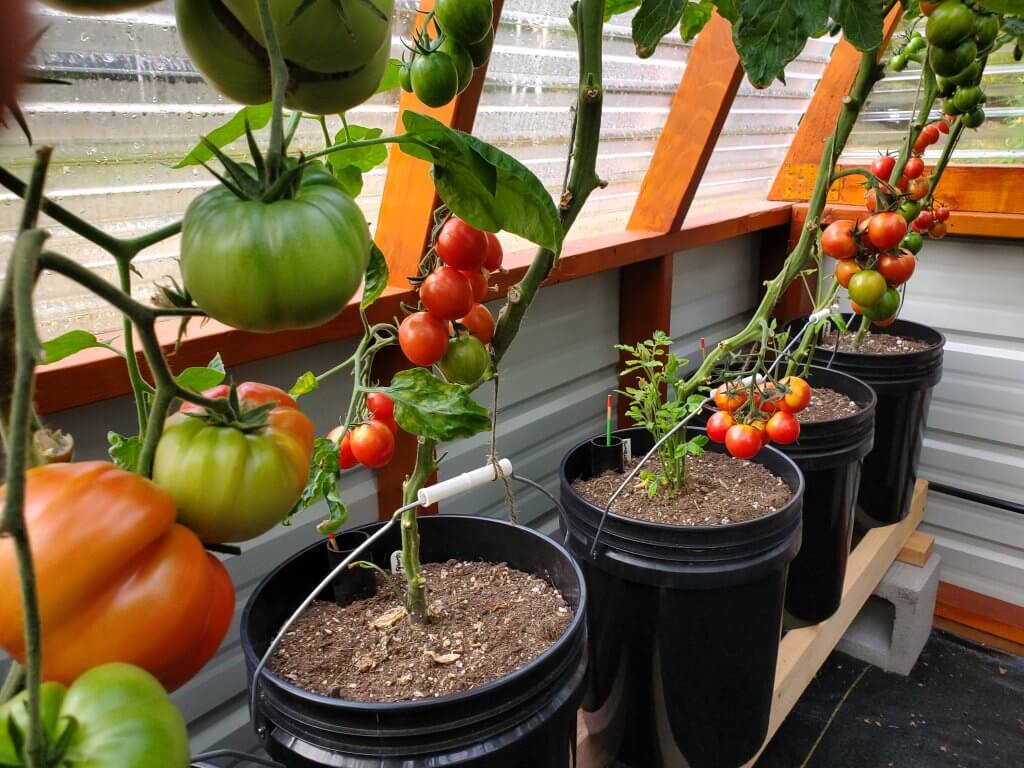
This image shows our late season indeterminate greenhouse cherry tomatoes. Notice that we have aggressively removed most of the lower foliage, leaving large clusters of tomatoes for further ripening.
We even top our tomatoes (literally, cut the growing tip off) somewhere between 4-6 weeks before first frost. This will allow all produced energy to be put into fruit production and ripening.
It’s also helpful to remove flower clusters late in the season, usually about 3-4 weeks before first frost. These flowers have no hope to become ripe tomatoes. Doing so will also help signal to the plant that it’s time to focus on ripening.
Indeterminate Pruning Summary
To summarize how we treat indeterminate tomatoes:
- Remove all suckers from the plant at all times
- Once the plant is about 3 feet tall, we remove the bottom foot of foliage
- Between 4-6 weeks before first frost:
- Top the tomato plant
- Trim the lower half 2/3 of the plant’s foliage
- Remove tomatoes that have no hope of getting to size
- Remove existing and upcoming flowers
Determinate Tomato Pruning
Determinate varieties will grow to a specific height (typically 4-6 feet) and then will stop growing larger. Most determinate tomatoes tend to be much more hands off when it comes to pruning, at least compared to indeterminate varieties.
For these tomatoes, you don’t need to trim the suckers and the plant will only get so wide and so tall. You can trim leaves or branches as needed, but in general you don’t have to do much with determinate varieties.
As with indeterminates, we like to remove the bottom foot or so of foliage once the plant is about 3 feet (1 meter) tall. This promotes air circulation and helps to ward off pests and diseases.
As with indeterminate tomatoes, we remove flowers and small tomatoes that appear within 4-6 weeks of first frost. These flowers and fruit have no hope of becoming good sized tomatoes and removing them helps the tomato plant focus on ripening!
A Month Before First Frost Is The End of Flowering As You Know It!
Given the impending frost that is coming, there comes a point where you need to shift the plants growth from creating new tomatoes to finishing the ones it all ready has.
The best way to do this is to remove all of the existing flowers that do not yet have tomatoes. Continue to be vigilant about maintaining suckers on indeterminate plants. Continue doing both these from a month before first frost until you fully harvest.
Removing the flowers will cause the plant to focus on maturing the fruit that exists. This is very important in cold climates because we often see plant-killing frosts in September. Any new fruit would not have an opportunity to mature anyway, so it’s important to help the plant focus on the fruit that is all ready growing.
With indeterminate varieties, it’s also a very good idea to top the plant around a month until first frost. Just cut the growing tip of the plant off. This again will cause the plant to put its energy into ripening fruit as opposed to getting even taller.
Bonus Subarctic Tomato Tip – Find Recipes For Green Tomatoes!
We’re sort of kidding, but really not. No matter how good a gardener you are, chances are good you are going to have a few green tomatoes at the end of the season.
Once frost is imminent, you’ll want to focus on harvesting all the tomatoes you can. Red, green – it doesn’t matter. Harvest them all.
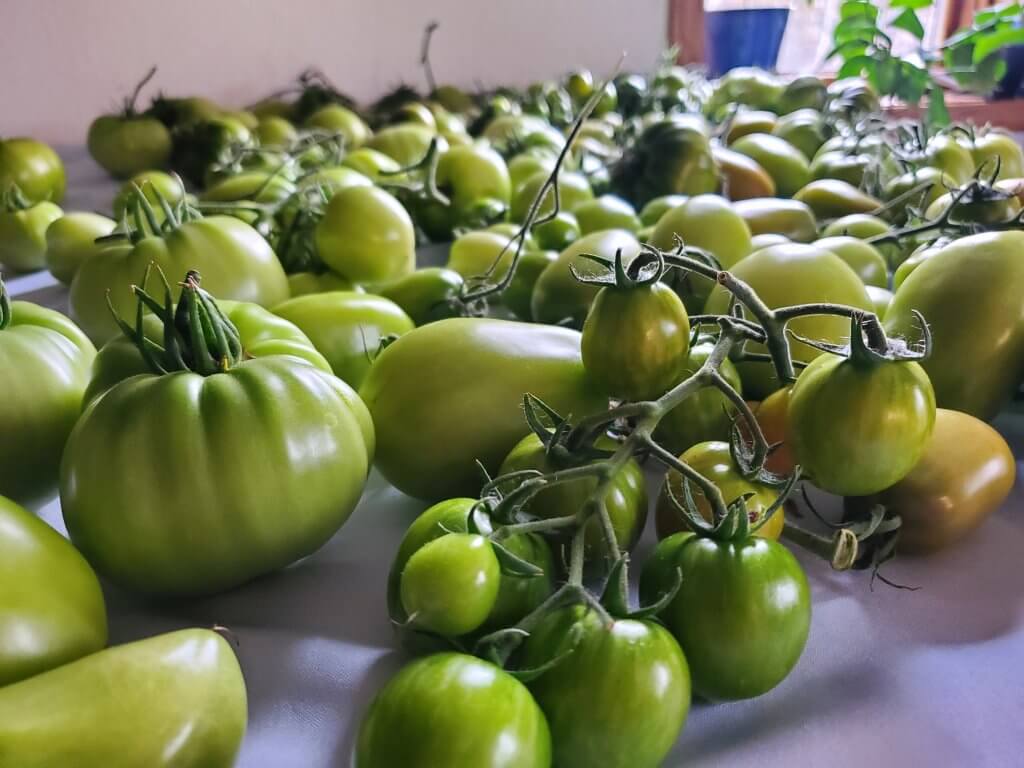
We always have a ton of green tomatoes at the end of the year. Every subarctic gardener’s book has an entire chapter on green tomatoes!
We only have so much time and without September or October available for outdoor crops to mature, you’ll have to take what you can get. The only way to get those extended seasons here in the subarctic is through a fully heated greenhouse.
Don’t think of green tomatoes like they are insufficient or not worth harvesting. They are absolutely worth it!
You can try to enclose your harvested green tomatoes in paper bags, which will help them mature. You can also put them on a table that is within reach of sunlight. Both of these techniques are not a miracle, but will definitely get your more ripe tomatoes than you had before.
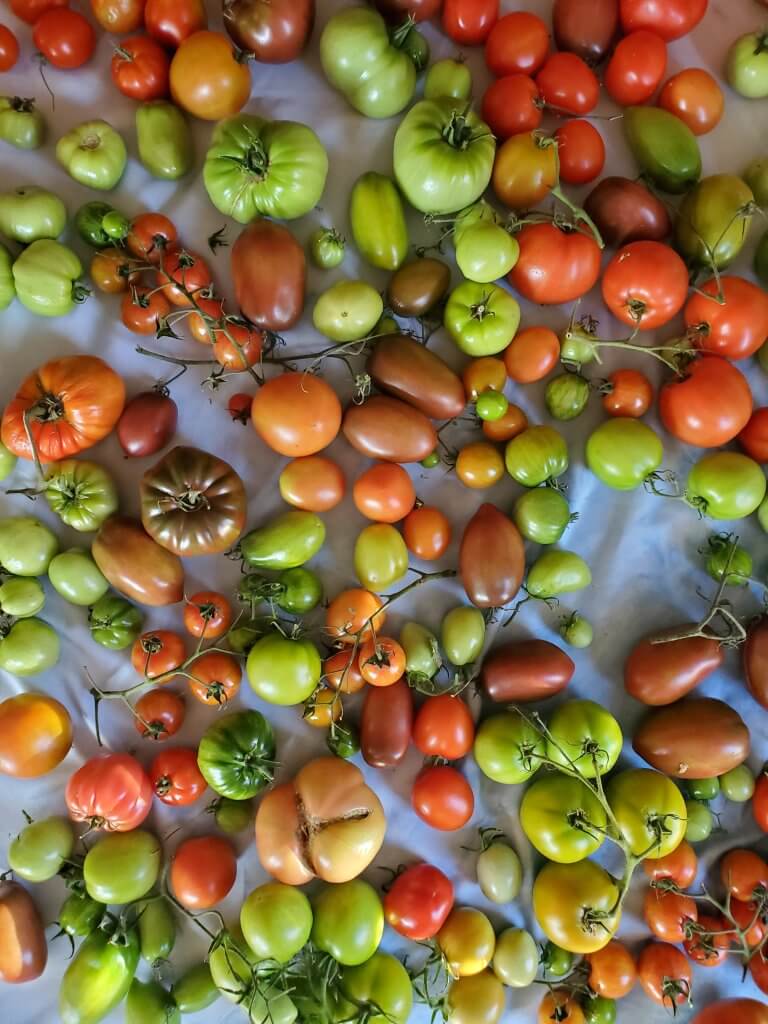
This is one of our final harvests of the season. Almost all of these were green tomatoes, but ripened after sitting in sunlight for about a week.
For everything that doesn’t ripen, there are tons of recipes for green tomatoes and many of them aren’t actually that bad. You can find green tomato salsa and other sauce like recipes that work really well with the green tomatoes. Even canned green tomatoes are a nice little snack through the winter months.
In Closing On Subarctic Tomatoes…
In closing of this subject, we did find a storage tomato variety that was bred to mature off the vine. It is an early producer and was never found on any variety list we’ve seen for Alaska. (Remember what we said in tip #1? Look for specific traits!)
This storage tomato variety is an early producing storage tomato and can be stored for several months off the vine, during which time it will mature more fully. These have produced well for us in Alaska and allow us to harvest them green while they mature over early winter.
We hope that you’ve found this focus article helpful and choose to raise some really awesome tomatoes. If you’ve found some varieties that do really well in subarctic areas, we would love to hear about them.
That’s All We Wrote!

Having a good time? We have an ever growing list of insightful and helpful subarctic & cold climate gardening articles, waiting out there for you!
- Cold Climate Gardening Basics 👉
- Growing Your Garden From Seed Indoors 👉
- Advanced Cold Climate Gardening Techniques 👉
- Plant Specific Cold Climate Growing Guides 👉
- Subarctic Perennial Food Forests & Foraging 👉
- Indoor Garden Lighting & Grow Rooms 👉
- Greenhouses & Temperature Control 👉
- Harvesting & Food Preservation 👉
- Solving Cold Climate Garden Problems 👉
- 1 Minute Reads On Tons Of Garden Topics 👉
FrostyGarden.com is 100% ad-free and we do not use affiliate links! This resource is voluntarily supported by our readers. (Like YOU!) If we provided you value, would you consider supporting us?

Thank you for this. We’re in the north of Scotland(UK), which is slightly milder than Alaska, most years 😉 The storage tomatoes were completely new to me, definitely trying those. Thanks again!
You are welcome! We are glad that we could contribute to your garden and wish you the best of luck. We love our Golden Treasure storage tomatoes. We still have a couple dozen that are still in good condition, harvested in August and it’s now January!
Last year we grew a variety of tomato called Northern Lights. We aren’t the MOST successful tomato gardeners, but last year was our best year ever. And Northern Lights was a standout. In the seed catalog it said it was a large, bicolor 55 day heirloom tomato with great flavor. SO glad we tried it. They did as well or better outside as in the greenhouse. Planted seeds along with 7 others about 12 days ago, and they were the first ones up, and taller than any others, and starting to get true leaves. You should try them!
That variety looks fantastic! I love the bi-color on the inside of the tomato as opposed to the more common skin variegation. I have put it on our buy list for 2021! Thanks for the tip, we’ll definitely try them out!
I LOVE all the info on tomatoe growing. I will try next spring to do this
Thanks Susie! Glad we could be helpful here and we appreciate your visit. We continually refine this post and others with new info and our long term goal is to get something like going for most common garden annuals!
Thanks for your informative article! I have had great success with Silvery Fir Tree tomatoes in Fairbanks, AK. They are a fern-leaf variety, very frost resistant.
Thanks for the comment Tim! That looks like an interesting variety and with a background like that, it’s no wonder it does well up here! We’ll see if we can get our hands on some seeds for 2022!
We are in FBX also and I would love to get my hands on some northern lights and silver fir. Just ordered ground cherries also so excited that they do well here 🙂
Happy gardening!
We really want to try them too. We will eventually trial them as we’ve heard great things about both Silver Fir and Northern Lights. It’s hard to choose between tried and true favorites and testing things out sometimes. Ground cherries are exceptional growers in our climate!
Great blog! Can’t believe I just found, saw a shout-out in News-Miner. Been growing tomatoes in North Pole 17 years. My go-to is Silvery Fir Tree. I have a couple extra if you want to try (if you haven’t before). Also…ground cherries! Tried?
Greetings Tim! Thanks for visiting us again, we enjoyed the opportunity to contribute to the News-Miner! We have the Silvery Fir Tree on our list, for sure, love the history of it. We are working on some experimental techniques this year to improve outdoor tomato production, specifically targeted at determinate tomatoes like the Silvery Fir. We love ground cherries here, some years they really pop off! Definitely a gem of northern nightshade production.
Thank you for all this great info! This is my first year gardening and I’m in Fairbanks, Alaska! I did container gardening on my deck and I’m growing Patio delights. The nights are now into the 40’s in late July so I have my plants against the house with a blanket and a hot water bottle at night. I’ve already harvested around 15 tomatoes and have about 30 more to go. Yesterday, I pruned off any remaining flower clusters. I also grew a nasturtium next to each plant which really seemed to help in the beginning… plus using tomato fertilizer. Again, thank you for your information!
This is great news! Glad you were able to get quite a few tomatoes. Sounds like you’re really taking care of them. Appreciate your kind comment.
Hi there! Have you ever tried using the “greenhouse” bags that go around individual tomato plants? We’re renting and don’t have space for a green house but I was curious if you have tried them or had any success. Thanks for all the info!
Hi there! Good question! We haven’t tried those specific products, but have seen them before. Based on our tests with our “Garbage Bag Greenhouses” (which are very similar, but DIY), they would have a positive impact. It won’t be quite as good as a temperature controlled greenhouse, but better than straight outdoors. It is important to pollinate the flowers under the bags, typically just by tickling the flowers occasionally with your fingers, otherwise you won’t get tomatoes. (Pollinators won’t go beneath the plastic, providing natural pollination.) Hope that helps! Good luck with your gardens!